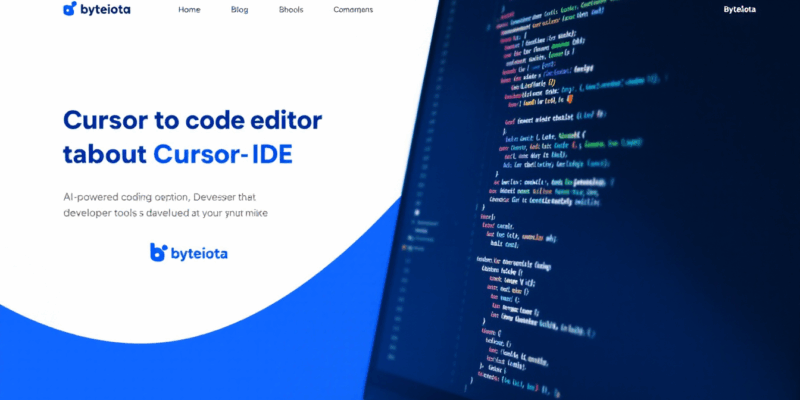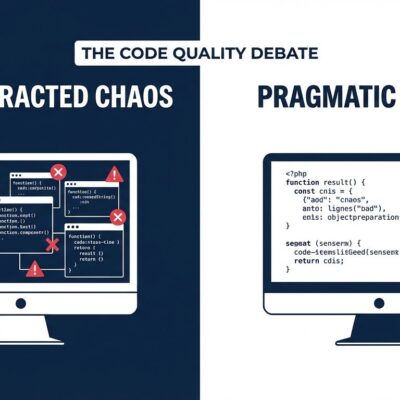
After a decade of unchallenged VS Code dominance, developers are defecting in growing numbers to Cursor IDE, an AI-first code editor that’s racked up over 40,000 GitHub stars. Built by former Anthropic engineers, Cursor isn’t just another VS Code fork with AI bolted on—it’s a fundamental rethinking of what a code editor becomes when AI is built into its foundation rather than added as an afterthought. This is the first serious challenge to VS Code’s 70%+ market share in years, and the migration numbers tell a story worth paying attention to.
AI-Native Architecture vs AI Add-Ons
The distinction between Cursor IDE and VS Code + Copilot isn’t about features—it’s about architecture. Cursor was built from the ground up with AI as a first-class citizen, enabling capabilities that feel native rather than tacked on. Multi-file editing works through natural language: tell Cursor to rename a class across 15 files, and it shows inline diffs before applying changes atomically. Ask about your codebase, and it maintains semantic understanding of entire projects up to a million lines of code.
VS Code + Copilot, by contrast, layers AI on top of an editor designed in the pre-AI era. Copilot excels at autocomplete but stumbles with cross-file refactoring or answering questions about code architecture. The difference shows in developer testimonials from Hacker News discussions: “Copilot felt like autocomplete++, but Cursor feels like having a senior dev who knows my entire codebase,” one user wrote after switching.
This architectural divide matters for the future of all developer tools. The question isn’t just which editor wins, but whether AI can be successfully retrofitted into existing tools or demands ground-up rebuilds. So far, Cursor’s growth suggests the latter.
Who’s Switching and Why
The migration wave isn’t random. Early adopters cluster around startups—particularly YC-backed companies—solo developers, and small teams where velocity trumps cost considerations. They’re willing to pay $20 per month for Cursor Pro, double GitHub Copilot’s $10 monthly fee, and accept potential vendor lock-in risks. The math must be working: developers consistently report 30-50% faster development for greenfield projects and 40-60% speed gains on refactoring tasks.
“It’s expensive, but I’m building features 30% faster,” a freelance developer explained on Reddit. “My clients don’t care what editor I use.” That sentiment captures the economic logic driving adoption. For professional developers billing $100+ per hour, a $20 monthly tool that saves even 5 hours pays for itself many times over.
Related: GitHub Copilot Workspace: AI-Powered Development Workflows
The typical adoption pattern follows a predictable arc: one or two team members try Cursor, evaluate productivity gains over 2-4 weeks, then advocate for team-wide rollout if the ROI is clear. The velocity gains aren’t just about typing faster—they’re about staying in flow state, reducing context switching, and letting AI handle tedious refactoring while developers focus on architecture and business logic.
The Cost-Benefit Debate
Not everyone’s convinced. The developer community remains divided on whether Cursor’s benefits justify its costs and trade-offs. Subscription fatigue is real: developers already juggle monthly bills for GitHub, cloud hosting, domain registrations, and monitoring tools. Adding another $20 monthly charge raises legitimate questions about ROI sustainability.
Vendor lock-in concerns run deeper. Unlike switching between text editors or even migrating cloud providers, becoming dependent on an AI-powered development environment introduces a new category of risk. What happens if Cursor raises prices, degrades service quality, or shuts down entirely? While Cursor’s fork of VS Code means migration back is technically feasible, workflows optimized around AI-native features don’t translate cleanly.
The extension ecosystem gap matters too. VS Code’s 30,000+ extensions represent years of community investment. Most work in Cursor—it uses the same extension API—but edge cases exist. For developers whose workflows depend on obscure or highly specialized extensions, that compatibility uncertainty carries real costs. The counter-argument: if AI integration delivers enough productivity gains, a smaller extension ecosystem becomes less critical. You need fewer extensions when AI handles tasks they used to perform.
Microsoft’s Response and the Future
Microsoft isn’t standing still. GitHub Copilot Workspace, announced in November 2024, represents their attempt to bring multi-file editing and AI agent capabilities to the VS Code ecosystem. It’s a direct response to Cursor’s challenge, adding features like project-wide code generation and task-based development workflows.
The critical question: can AI be successfully retrofitted into VS Code’s architecture, or does it require Cursor’s ground-up approach? Microsoft has resources and market position on their side. Cursor has architectural advantages and developer momentum. The competition benefits developers regardless of which approach wins—AI tooling will improve faster with real market pressure.
Beyond this specific battle, Cursor signals something larger: the emergence of AI-native developer tools as a distinct category. Other tools follow similar patterns—Replit’s AI app builder, AI-powered testing frameworks, database tools with native AI query optimization. These aren’t traditional tools with AI features added. They’re tools reimagined around AI capabilities from their foundations.
Key Takeaways
- Cursor IDE represents the first serious challenge to VS Code’s decade-long dominance, driven by AI-native architecture rather than bolted-on features
- Developers are paying double Copilot’s price ($20 vs $10 monthly) for 30-50% productivity gains, suggesting AI-powered development tools command premium pricing
- The architectural debate—AI-native vs AI-enhanced—may determine whether existing developer tools survive or get displaced by ground-up rebuilds
- Microsoft’s Copilot Workspace response shows the incumbent won’t cede ground easily, setting up a competition that benefits all developers
- Cursor’s success signals a broader shift toward AI-native tooling across the developer stack, not just code editors



